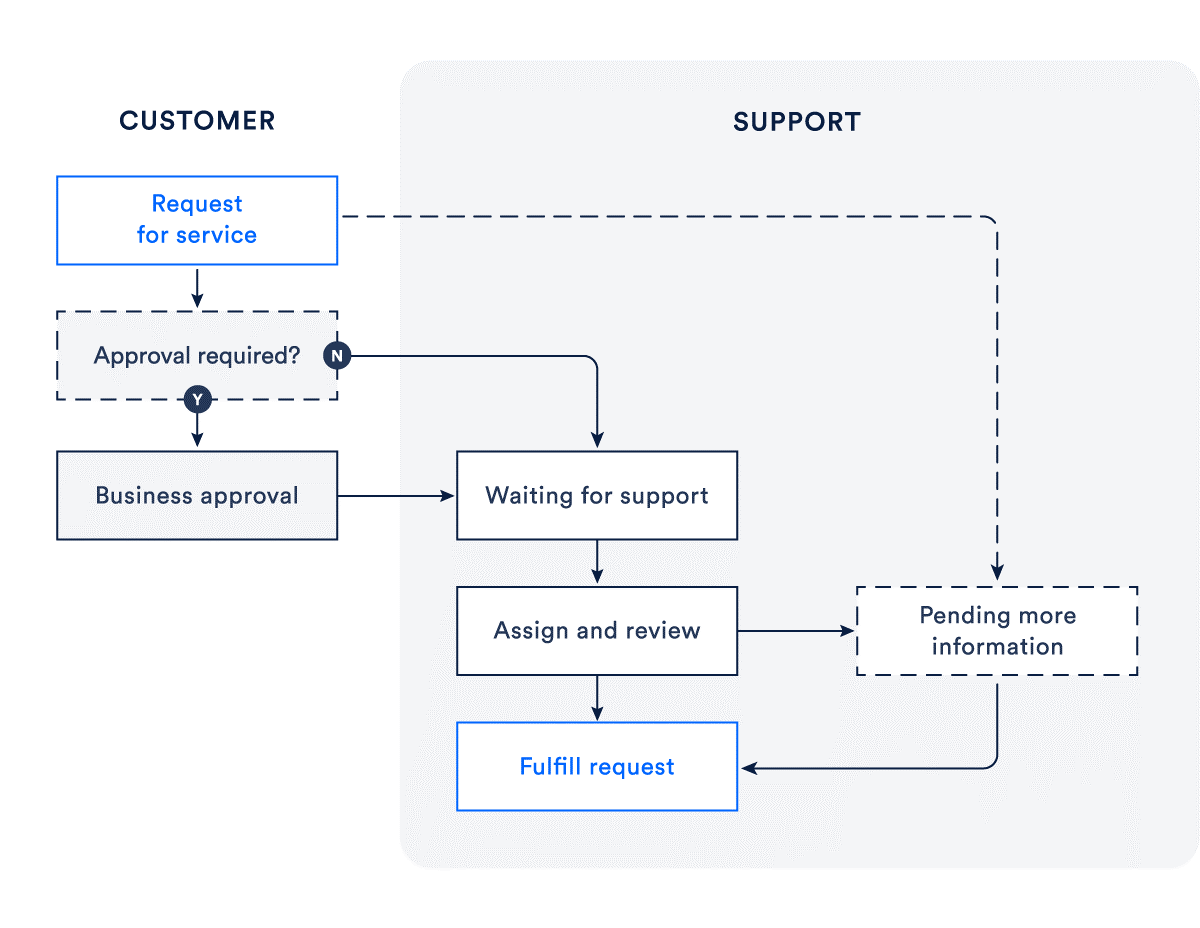5 SECONDS SUMMARY:
- Good service order management can speed up the delivery of your services and allow you to provide those services with less effort;
- In this article, you’ll learn how to manage requests using Jira Service Management.
Service requests are requests for something new. These are usually low-risk requests that can be resolved quickly and are separate from incidents, problems and changes.
Service Request Management (SRM) helps organisations standardise how they respond to, coordinate and fulfil service requests. It is one of the leading practices in ITSM.
Enterprise Service Management (ESM) extends ITSM to business teams, such as onboarding a new employee, revising a legal contract or setting up a new office.
Good service order management can speed up the delivery of your services and allow you to provide those services with less effort.
Order resolution: What is it?
Order resolution is a process managed by the service team – Service Desk – consisting of responding to customer requests. Its mission is to provide the highest level of customer service support. In an organisation where many service requests must be managed, it is recommended to manage them in an independent workflow that makes it possible to record and handle them separately from other IT processes.
What are the four fundamental IT processes?
1. Service request management – a formal request from a user for something new to be provided.
2. Incident management – an unplanned interruption of an IT service or a reduction in its quality – for example: “website down”.
3. Troubleshooting – eliminate recurring incidents and minimise incidents that cannot be prevented – for example: “The reporting application problem is occurring again.”
4. Change management – standardised methods of controlling changes to the IT system to minimise the impact on services (adding, modifying or removing something) – for example: “The database upgrade is now complete”.
Prioritisation in the management of service requests
For IT teams in organisations, service requests often exceed capacity in terms of time and resources. IT service teams in large companies constantly respond to business requests and often “go into mode”: reacting first to customers who demand attention most persistently. However, customers complain that the IT team is challenging to work with, unresponsive and takes too long to close the requests they need to work on. Service request management simplifies this process, providing customers with a “self-service” capability, providing responses based on suggestions from a “knowledge base”, and streamlining the entire process of resolving issues. Orders are delivered instantly, excellent service. Considering all these issues, there are a few things that IT service teams should prioritise.
Top 5 priorities for delivering excellent IT service
- Focus on the customer – knowing your customer and checking which processes and IT managers need to be implemented is essential. With this information, you can work around the needs and expectations of the client, resulting in the optimisation and improvement of processes to generate better results. What works for one client cannot consistently be replicated in the same way for others. Are you creating a service request catalogue with self-service features because you think it’s a good idea in general, or are you working directly with your customers to meet their most pressing needs? Many organisations have opted for service request catalogue portals but have seen low usage. Learn from others’ mistakes and create something based on demand rather than supply.
- Ticket prioritisation – using a process and priority matrix, IT teams can automatically prioritise a request based on its impact and urgency. “Service desk” teams can also assign tickets using automatic attributions with automation. This does not overload the team during the initial phase and accelerates an improvement in response and resolution times, satisfying customer Service Level Agreements (SLAs).
- Centralised, searchable knowledge management – solutions to recurring service requests can be stored in a knowledge base. Users can find articles referencing suitable solutions to their own problems using a centralised, searchable knowledge base, reducing the service desk workload, minimising costs and increasing end-user self-sufficiency.
- Centralise and make the most of the self-service portal – customers always go to one place when they seek help. Even if you develop the most powerful self-service system, it will be useless if customers cannot find it easily. It should always strive towards centralisation and increase the value provided to customers when they use the service catalogue. In addition, teams can create customised service request templates with sections and resource details to receive the information they need in a standardised way. Each model can be given its own set of workflows, automatic SLA enforcement and necessary tasks to deliver the service. With role-based access to the service request template, service desk teams can ensure that only the right services are displayed to the intended users.
- Use automation – providing highly functional, knowledge-centric service request management is a significant first step. Still, ways need to be found for IT staff to deliver even better value to their customers via self-service experiences. The power to be effective here lies in automation. Incorporating automation into your service desk features will reduce your IT team’s overall workload by removing common, repetitive tasks. Automation can also be used to route service requests to the appropriate team for faster resolution of appeals.
The service request management process
While there may be variations in how a service request is resolved, it is crucial to focus on how you can use standardisation to improve the overall quality and efficiency of the service. The schema below represents a simple service request resolution process based on ITIL recommendations, which can be used as a starting point for adapting existing processes or defining new ones.

- A customer requests support via your service portal or by email. Some orders can be redirected by providing the required information with a knowledge base, while others can be automatically routed for approval using automation.
- The service desk team analyses and classifies the request in line with the qualification and approval process.
- A “service desk” team member works to answer and resolve the service request or forwards the request to someone who can handle it.
- After solving the request, the “service desk” team member closes the ticket. To ensure that the customer’s request has been properly resolved, a short form can be automatically sent to the customer to measure customer satisfaction.
Eight tips to consider when defining service requirements
- Start with the most frequently requested items and choose those that are most quickly and easily resolved. This will allow you to deliver immediate value to your customers and allow the service desk team to learn as they build future phases of the service request catalogue.
- Document all service request requirements (request date, approval process, resolution procedures, resolution team, process “owners”, SLAs, reporting, etc.) before adding them to your catalogue. This will enable the IT team to better manage the various order requirements over time. This step is crucial for more complex requests that will evolve in the future and guarantees continuous improvement of the service offered.
- Capture the data needed to initiate ordering processes but leave your customer with enough questions. To this end, a script or customised service scripts can be created for the “service desk” team, depending on the type of request in question.
- Standardise the approval process whenever possible. For example, all orders for new monitors are considered pre-approved, and all software orders require approval from the customer’s superior. Automation can make a big difference at this stage.
- Review the process and procedures for resolving a request to identify which support teams are responsible for responding and if there are any specific requirements. Again, automation can play an essential role in distributing the order across groups based on the information initially provided when opening the order request.
- Identify what knowledge should be made available in the knowledge base or “knowledge base” when an order offer is released. ” self-service ” aims to get your customers what they want faster and redirect orders whenever possible. This way, you can answer questions through a simple FAQ, including this knowledge as part of the plan when creating a service request offer.
- Review Service Level Agreements (SLAs) to ensure that you have the right metrics and notifications properly defined, allowing requests to be resolved in a manageable time frame.
- Identify what reporting is required to manage the entire lifecycle of a service request correctly and its catalogue in the long term. One can start the necessary tracking with metrics like customer satisfaction, response time, resolution and closure.
Service request management with Jira Service Management
Jira Service Management is at the heart of Atlassian’s technology approach to managing IT Service Requests (or IT Service Management – ITSM). Built on the Jira platform, Jira Service Management is designed from the ground up for IT teams and other departments such as HR services, facilities and marketing, among others, as the most collaborative service desk solution on the market. So why use Jira Service Management to manage service requests?
We will leave it to a recent Xpand IT customer, SUMOL+COMPAL, to provide the answer to this through a report by Exame Informática on the successful partnership with our teams.

Collaboration Solutions Project Manager – Xpand IT














